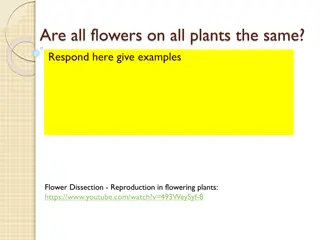Understanding Bee-Friendly Flowers and Nectar Preferences
Leafcutter bees are busy making nests this month, highlighting the importance of flowers in attracting different bee species based on shapes, nectar availability, and tongue lengths. Different bees prefer various flower shapes for nectar, with long-tongued bees favoring tube-shaped flowers like snapdragons. Short-tongued bees opt for open flowers such as sunflowers, while medium-tongued bees can feed on a variety of shapes. Providing a diverse range of flower shapes is crucial to support multiple bee species. Enjoy a learning activity on spotting different flower shapes and understanding the significance of nectar production in flowers.
Download Presentation

Please find below an Image/Link to download the presentation.
The content on the website is provided AS IS for your information and personal use only. It may not be sold, licensed, or shared on other websites without obtaining consent from the author. Download presentation by click this link. If you encounter any issues during the download, it is possible that the publisher has removed the file from their server.
E N D
Presentation Transcript
May This month, leafcutter bees are cutting small pieces of leaf to make nests for their young. Learn about: why different flowers attract different types of bee. Which flower shapes do bees prefer? Bees need nectar as a food to give them energy. When they look for nectar, what sort of flowers are they making a beeline for? Different types of bee have evolved to have different tongue lengths. This means that they are not all competing with each other to feed from the same flower shapes. Long-tongued bees can feed from flowers shaped like tubes such as snapdragons. Their long tongues mean they can reach their nectar reward. Short-tongued bees need their nectar to be easier to reach and prefer open flowers, like sunflowers. Some short-tongued bees have learned to steal nectar from tube-shaped flowers by nibbling a hole at the base of the flower and feeding from the outside. Bumblebee feeding on a sunflower Bumblebee stealing nectar by nibbling a hole in the bottom of the flower
Other bees have medium-length tongues. This means that they are able to feed on lots of different flower shapes. It can take time for bees to learn how to get to nectar from more complicated flower shapes, such as trumpet-shaped flowers. When you think about which plants to grow, it is a good idea to have lots of different flower shapes available. This means there will be nectar available for many different types of bees. A variety of flowers including spike and umbrella shapes.
2 3 4 5 1 Learning activity: become a flower spotter. Use the guide to see which flower shapes are growing outside. bell capitulatum cluster corymb cruciform 10 6 7 8 9 How many different shapes can you find? cup double pompom raceme salverform 11 12 13 14 15 16 saucer solitary spike stellate trumpet umbel
Home | Nectar Sweet liquid, produced in flowers.
Home | Evolved To have changed over time in order to be able to survive more successfully.























